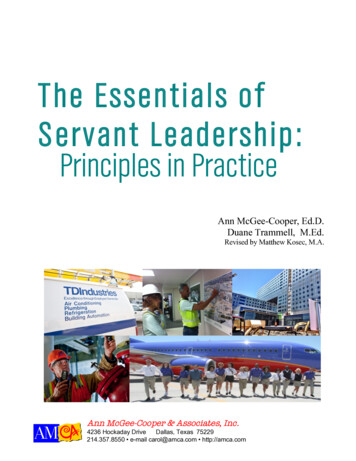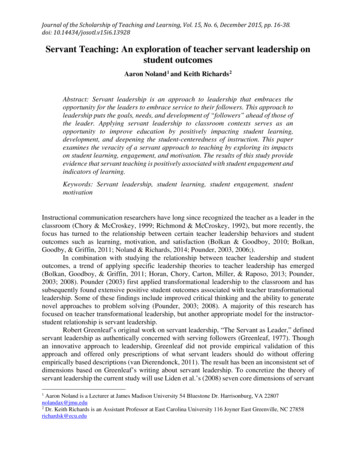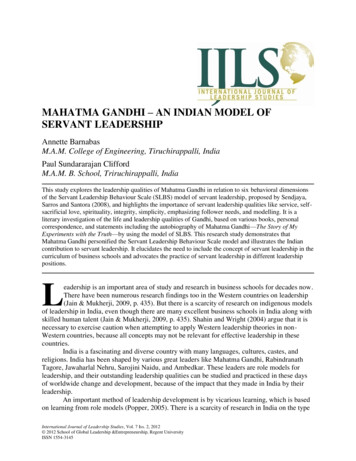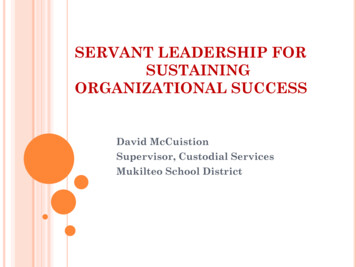
Transcription
The Essentials ofServant Leadership:Principles in PracticeAnn McGee-Cooper, Ed.D.Duane Trammell, M.Ed.Revised by Matthew Kosec, M.A.Ann McGee-Cooper & Associates, Inc.4236 Hockaday DriveDallas, Texas 75229Copyright 2001,2013 Ann McGee-Cooper & Associates,Inc.214.357.8550 e-mailcarol@amca.comhttp://amca.com
The Essentials of Servant Leadership:Principles in Practiceby Ann McGee-Cooper, Ed. D., Duane Trammell, M.Ed(revised, 2013 by Matthew Kosec, M.A.)An organizational and spiritual awakening is currentlytaking place. More people in the new millennium areseeking deeper meaning in work beyond financialrewards and prestige. The desire to make a difference,to support a worthwhile vision, and to leave the planetbetter than we found it all contribute to this new urge.At the same time, the sustainability movement is helpingraise a new awareness of tremendous waste in ourcurrent ways of doing business. Perhaps no greaterwaste exists than the loss of a true sense of community,human imagination and creativity, shared vision, andempowered teamwork found in many of ourorganizations—all of which ultimately underminesindividual productivity and corporate performance.We must pay attention to these trends because of thetightening labor market and the new generations—withdifferent values and expectations— moving into ourworking ranks. If companies want to attract and keeptop talent, the old ways of recruiting, rewarding, andleading won’t get us there. A different type ofleadership is required to succeed in the future.Servant leadership is one new model that has provedsuccessful in a growing number of organizations.Companies ranging from a large airline, a retail storechain, a mechanical/electrical construction and servicecompany to an engineering/construction partnershipwith a public hospital are experimenting withunprecedented and accelerated changes in whomEmployees choose to follow, how they lead, and howthey come together to address constant flux. Thisarticle includes stories from these workplaces,differentiating servant leadership from traditional,hierarchical leadership models. It also offerssuggestions for putting servant leadership principles towork—any time, any place.ContentsThe Roots of Modern Leadership Models . . . . . . . . . .2A New Kind of Leadership . . . . . . . . . . . . . . . . . . . . . . 2How Servant Leadership Serves Organizations . . . . .6Capitalizing on Employee Knowledge andTotal EngagementBuilding Strong InterdependenceMeeting Stakeholder NeedsMaking Healthy DecisionsMaintaining a Clear Awareness of ParadoxTDIndustries: Embodying the Art ofServant Leadership. . . . . . . . . . . . . . . . . . . . . . . . . . . .9How Servant-Leaders Grow More Servant-LeadersBuilding a Shared Vision of Servant LeadershipThe PayoffLinking Learning Organizations: SLLCParkland Building the Largest Public Hospitalin the World Using Servant Leadership. . . . . . . . . . .16Southwest Airlines: Keeping ServantLeadership Alive . . . . . . . . . . . . . . . . . . . . . . . . . . . . .17The Power of Internal MotivationThe Culture CommitteeHow to Begin Practicing Servant Leadership . . . . . 19Why Leadership Styles Matter! . . . . . . . . . . . . . . . . 21Copyright 2001, 2013 Ann McGee-Cooper & Associates, Inc.
The Essentials of Servant Leadership: Principles in PracticeThe Roots of ModernLeadership ModelsWhat are the roots of thepredominant leadershipmodels of the 20th century?Start with the machinemetaphor and managers whobelieved that people inorganizations should operatelike cogs in a well-oiledmachine. Businesses in theIndustrial Revolution soughtworkers who could completerepetitive tasks in the mostefficient way possible. Tothat end, factories, railroads,mines, and other companiesadopted a top-down view ofleadership, where those at thetop—the “head” of theorganization—controlled allthe information, made all thedecisions. Leaders calledthose at the bottom of thehierarchy “hired hands,” andrewarded them for conformityand unquestioned obedience.In fact, many viewed anyquestioning of the boss asinsubordination or grounds fordismissal.2Over the last 50 years, ourways of preparing new leadershave stemmed directly fromthese roots. For the most part,we still employ the terms“manager” and “leader”interchangeably, with noapparent recognition thatthings are managed, butpeople are led. Leadershiptraining in MBA coursescontinues to rely on a casestudy approach, in whichstudents study patterns of howothers solved businessproblems in the past. Thisprocess assumes that if youlearn enough from successfulcase studies, you can matchyour company’s challengesagainst these templates andsuperimpose similar solutions.However, as the pace ofchange accelerates and theworld becomes increasinglycomplex, many companiesmust unlearn the mindset ofbasing the future on the past inorder to handle emergingproblems that are differentfrom anything they’ve facedbefore.Instead ofbreakingissues intoparts tounderstandand control,today’sleaders mustlearn to stepback andinvolveCopyright 2001, 2013 Ann McGee-Cooper & Associates, Inc.others in looking atconnections, relationships,systems, and patterns.As a result, the leader’s rolehas changed from that ofomniscient boss to that ofcoach. In this new businessenvironment, managers findthat they are more successfulin accomplishing their goalswhen they practice the arts ofdeep listening, persuasion, andtrust rather than rely on theexercise of power. Somedescribe this transformation asturning the pyramid of powerupside down. Others havetermed this new paradigm“servant leadership.”A New Kind of LeadershipServant leadership is onemodel that can help shifttraditional notions ofleadership andorganizations—and preparecompanies to face thechallenges of an uncertainfuture. Robert K. Greenleaf, alifelong student oforganizational change, cameup with the term “servantleadership” after readingJourney to the East byHermann Hesse. Greenleafwas reading the book as partof his effort to help universityleaders deal with the studentunrest of the 1960s. In tryingto understand the roots of theconflict, Greenleaf put himselfin the students’ shoes andbegan to study what
The Essentials of Servant Leadership: Principles in Practiceconsumed their interest.In Hesse’s story, Leo, acheerful, nurturing servant,supports a group of travelerson a long and difficultjourney. His sustaining spiritkeeps the group’s purposeclear and morale high until hedisappears one day. Soon, thetravelers lose heart anddisperse. Years later, thestoryteller discovers that Leois the highly respected leaderof a spiritual order. Thenarrator comes to recognizethat Leo was important to thesurvival and sharedcommitment of the travelersprecisely because he servedothers. From this story,Greenleaf gained insight intoa new way to perceiveleadership—leading byserving. In Greenleaf’s mind,this approach represented atransformation in the meaningof leadership.What is servant leadership, asit has evolved fromGreenleaf’s early musings?Greenleaf described it in thisway: “[Servant leadership]begins with the natural feelingthat one wants to serve, toserve first. Then consciouschoice brings one to aspire tolead. This is sharply differentfrom the person who is leaderfirst, perhaps because of theneed to assuage an unusualpower drive or to acquirematerial possessions. . . . TheThe Essentials of Servant Leadership: Principles in Practicebest test for servant leadershipis: do those served grow aspersons; do they, while beingserved, become healthier,wiser, freer, moreautonomous, more likelythemselves to becomeservants? And, what is theeffect on the least privilegedin society; will they benefit, orat least, will they not befurther deprived?” Jesus,Gandhi, Nelson Mandela,Cesar Chavez, and MotherTheresa stand out ascompelling examples of thismodel.Servant leadership contrastssharply with commonWestern ideas of the leader asa stand-alone hero (see “TheHeroic Leader Versus theServant-Leader” on p. 5).Hollywood glamorizes theimage of the lone warrior whoovercomes tremendousadversity. The movie industryfeeds a national—andgrowing international—publicCopyright 2001, 2013 Ann McGee-Cooper & Associates, Inc.hunger for this model. We alllove to see the “good guys”take on the “bad guys” andwin. Our movie heroes actquickly and decisively,blowing up buildings andwrecking cars and planes inspine-tingling chases. Thisdiet of high drama can fool usinto believing that we canalways depend on one or two“super-people” to solve ourcrises.Our collective longing for asavior to fix the messes thatwe have all helped createspills over to our work life.Even in impressive corporateturnarounds, we look for thehero or heroine of the success.We tend to see anything otherthan decisive quick fixes astoo slow or “wimpy” to beeffective.But perhaps we arecelebrating and rewarding thewrong things. In actionmovies, although the heroesalways win at the end byannihilating or capturing thebad guys, they leave behind apath of blood and destruction.In business, a new leader maycome in, implement adramatic downsizing, andshow a quick profit. But he orshe may then move on beforethe impact of the broken trustthat results from these actionsshows up in loss ofproductivity, damage tocustomer loyalty, and poor3
stock performance.A leader who sees him- orherself as a servant above allelse, however, plays quite adifferent role than does thetraditional hierarchical leader.Rather than controlling orwielding power, this person(1) first listens deeply tounderstand the needs andconcerns of others; (2) worksthoughtfully to help build acreative consensus; (3) honorsparadox (searches out thebalancing truths from withinopposing views); and (4)works to create “third rightanswers” that rise above thecompromise of “we/they”negotiations.Robert Greenleaf and Ann McGee-CooperThus, servant leadershipfocuses on 4sharing vital “big-picture”information essential forholistic understanding, building a sharedvision, managing self, fostering highlevels ofinterdependence, learning frommistakes, encouragingcreative inputfrom every teammember, spending time to questionpresent assumptions andmental models, modeling and buildingshared trust, and embracing a humble spirit.“A servant-leader is aperson who begins with thenatural feeling of wanting toserve first – to help, support,encourage, and lift upothers. And because of theirnoble role model, othersbegin to lead by serving.” Robert K. GreenleafTo paraphrase Greenleaf,servantleadershipis notabout apersonalquest vant asleader begins with a truemotivation for nurturingothers. This leader lifts upothers and actively engages ingrowth and development ofthose being served, as well asCopyright 2001, 2013 Ann McGee-Cooper & Associates, Inc.their own. Servant leadershipcomes from a maturemotivation, which for manyemerges later in life. As webegin to recognize our ownmortality, we may begin towonder: “What can Icontribute that will continuelong after I am gone?”For some, this quest to leavebehind a legacy involveshaving their name on a libraryor some other form of publicrecognition. For servantleaders, it’s about liftingothers to new levels ofpossibility and accomplishingas a team much more thanwhat one person mightaccomplish alone. Theseindividuals find that themagical synergy that resultswhen they put aside theiregos, share visions, andnurture true organizationallearning brings collective joy,deep satisfaction, and amazingresults!
The Essentials of Servant Leadership: Principles in PracticeThe Heroic Leader Versus the Servant-LeaderTRADITIONAL BOSS OFPOWER-BASED LEADERSERVANT AS LEADER1. Begins with a personal drive to achieve topposition of power1. Begins with a desire to serve others from anyplace in the organization.2. Operates in a highly competitive manner.Possesses an independent mindset. Finds itimportant to receive personal credit forachievement.2. Operates in a highly collaborative andinterdependent manner. Knows that all cangain by working together to createwin/win/win solutions. Gives credit to others.3. Uses personal power, fear, and intimidation to 3. Uses personal trust, respect, andget what s/he wants.unconditional love to build bridges and dowhat’s best for the “whole.”4. Focuses solely on fast action.4. Focuses on gaining understanding, input, andbuy-in from all parties on essential issues.Understands that faster is often slowerbecause people support what they help create.5. Relies only on facts, logic, and proof.5. Uses intuition and foresight to balance facts,logic, and proof.6. Controls information in order to maintainpower6. Shares big-picture information. Coachesothers by providing context and askingthoughtful questions to help them come todecisions by themselves.7. Spends more time telling and giving ordersthan listening.7. Listens deeply and respectfully to others,especially to those with dissenting views.8. Derives a sense of confidence and personalworth from building his or her own talentsand abilities.8. Derives a sense of fulfillment frommentoring, coaching, and growingcollaboratively with others.9. Sees supporters as a power base. Uses perksand titles to signal to others who has power.9. Develops trust across constituencies and seesthe ability to facilitate interdependentsolutions as a core value. Breaks downneedless barriers caused by hierarchy.10. Speaks first and believes that his or her ideasare the most important. Often dominates theconversation and intimidates opponents.10. Listens first. Values others’ input, invitesothers into the conversation, and is able tobuild strength through differences.11. Understands internal politics and uses themfor personal gain.11. Is sensitive to what motivates others andbalances what is best for the individual withwhat is best for the group.12. Views accountability as assigning blame.12. Views accountability as creating a safeenvironment for learning. Ensures thatlessons learned from mistakes are shared.13. Uses negative humor (often put-downs andsarcasm) to control, ridicule, or excludeothers.13. Uses inclusive humor to lift up others andmake it safe to learn from mistakes. Is thefirst to let themselves become vulnerable.Copyright 2001, 2013 Ann McGee-Cooper & Associates, Inc.5
The Essentials of Servant Leadership: Principles in PracticeHow Servant LeadershipServes OrganizationsBut what benefits canbusinesses glean from thepractice of servant leadership?Servant-leaders naturallyawaken and engage Employeeknowledge, build stronginterdependence within andbeyond the organization’sboundaries, truly meet andexceed the needs of numerousstakeholders, make wisecollective decisions, andleverage the power ofparadox. We explore each ofthese capabilities in greaterdetail below.leaders help individuals growwith their jobs. It alsofrom being mere hired handssupports eliminating theto having fully engaged minds“that’s not my job” syndrome.and hearts. Workers then feelThe practices of servantsafe to widely share theleadership challenge somelessons they’ve learned frombasic assumptions often heldmistakes in the spirit of seeingabout the roles differentthe patterns or systems in allpeople play in helping athat they do. People becomecompanyleadersThe practices of servantachieveandsuccess.partnersleadership challengeWhen we shiftwithinsome basic assumptionsourtheperspective,often held about the rolesteam ascommontheirdifferent people play inmanagementhelping a companyexpressionssuch asachieve success.Capitalizing on EmployeeKnowledge and TotalEngagementvaluable insights become vitalto continuous improvementand learning.Servant leadership is apowerful methodology fororganizational learningbecause it offers new ways foran organization to engage theknowledge and wisdom of allits Employees, not just those“at the top.” Servant-leadersshare big-picture informationand business strategiesbroadly throughout thecompany. By communicatingbasic assumptions andbackground information, theyempower each person toparticipate in decision-makingand creative problem solving.By encouraging innovationand making it safe to makeand learn from mistakes, theseFor example, as part of itscommitment to servantleadership, for the last 15years, TDIndustries, one ofAmerica’s premiermechanical construction andfacility service companiesheadquartered in Dallas,Texas, has taught itsEmployee-owners (called“Partners”) to understandfinancial statements. Partnerstake this responsibilityseriously; after all, they ownthe company. TDIndustriesand others have found thatsharing this kind ofinformation significantlyincreases Employees’ jobsatisfaction and engagement6Copyright 2001, 2013 Ann McGee-Cooper & Associates, Inc.“subordinates,” “my people,”“staff” (versus “line”),“overhead” (referring topeople), “direct reports,” and“manpower” no longer seemuseful or accurate. Thestandard way of thinking failsto encompass a respect forpeople, a desire to supportothers in fulfilling theirpotential, and the humility tounderstand that the work ofone person can rarely matchthe work of an alignedinterdependent team.Building StrongInterdependenceServant-leaders see all peopleas having the capacity togrow, take initiative, both leadand support others, and come
The Essentials of Servant Leadership: Principles in Practicetogether around a sharedvision. They know that ateam with mediocre talent buthigh levels of trust cantypically far outperform agroup of stars trying tooutshine each other. Servantleaders work to build a truecommunity, knowing thatclose relationships bringpeople together in toughtimes. This approachcontrasts sharply with thecompetitive models that pitteammates against each other.Phil Jackson, coach of severalworld-champion basketballteams, knows the importanceof fostering supportiverelationships among teammembers. In his book, SacredHoops (Hyperion, 1995), hewrites, “Good teams becomegreat ones when the memberstrust each other enough tosurrender the ‘me’ for the‘we.’ As Bill Cartwright putsit: ‘A great basketball teamwill have trust. I’ve seenteams in this league where theplayers won’t pass to a guybecause they don’t think he isgoing to catch the ball. But agreat basketball team willthrow the ball to everyone. Ifa guy drops it or bobbles it outof bounds, the next timethey’ll throw it to him again.And because of theirconfidence in him, he willhave confidence. That’s howyou grow.’” Interdependentteams succeed because theybuild confidence in membersby showing them trust, evenwhen a member occasionally“drops the ball.”Highly successful coacheswho understand the potentialof interdependence is notlimited to basketball.Consider Herb Brooks, thecelebrated coach who led themonumental upset of the thenSoviet hockey juggernaut bythe 1980 United StatesOlympic Hockey Team. Ascritics pointed out, none of hisyoung players wererecognized as the best of theworld. Brooks was unfazedby the criticism: “You'relooking for players whosename on the front of thesweater is more importantthan the one on the back. Ilook for these players to playhard, to play smart and torepresent their country.”Brooks’ team soared to theunexpected “Do you believein miracles?” gold medalbecause an interdependentteam focused on the overallgoal will always outperforman assembly of individualswho lack trust and are onlyconcerned about theirpersonal agenda.Meeting Stakeholder NeedsA servant-leader is alsokeenly aware of the needs ofa much wider circle ofstakeholders than just thoseinternal to the organization.For instance, Ray Anderson,former chairman and CEO ofInterface, one of the largestinternational commercialcarpet wholesalers,challenged his company tojoin him in leading what hePhil Jackson and Kobe BryantCopyright 2001, 2013 Ann McGee-Cooper & Associates, Inc.7
The Essentials of Servant Leadership: Principles in Practicecalled the second IndustrialRevolution. He defined thisnew paradigm as one inwhich businesses find waysto operate that respect thefiniteness of naturalresources. His vision, whichhis Employees embraced,was never again to sell asquare yard of carpet.Instead, the organizationchallenged itself to leasecarpeting and then find waysto achieve 100 percentrecycling—“zero tolandfill!” Ray’s legacycontinues as Interfaceembraces Mission Zero.“We’re going for zero.Mission Zero. Zeroemissions. Zero waste. Zerooil. It is our promise toeliminate any negativeimpact our company mayhave on the environment bythe year 2020. That’s right.ZERO oil. It’s a toughchallenge since carpet ismade from oil, and we’remore than halfway there.”Thus, the principles of servantleadership define profitbeyond financial returns toinclude meaningful work,environmental responsibility,and quality of life for allstakeholders. As a result,Employees feel a deeperpersonal commitment to theirwork as they truly make theworld better in the process ofearning a living. As RobertGreenleaf said, “If a better8society is to be built, one thatis more just and loving, onethat provides greater creativeopportunity for its people,then the most open course isto raise the capacity to serveand the very performance asservant of existing institutionsby new regenerative forcesoperating within them.”managers. Instead, they usecrises as opportunities tocoach others and help teamslearn from mistakes. You cansee the results of servantleadership in some ofAmerica’s most interestingand progressive companies(see “Servant leadership at the100 Best Companies to Workfor in America”).Making Healthy DecisionsToo many people inorganizations today sufferfrom “hurry sickness.” Whenwe focus on doing everythingfaster than before, our bodiesflood with adrenaline. As theeffects wear off, we cravemore of this addictivesubstance. To feed thishunger, we neglect proactivetasks such as coaching,mentoring, planning ahead,and quiet reflection. Instead,we seek out more reasons tostay reactive and highlycharged.Servant-leaders model healthydecision-making by taking thetime to withdraw, to reflect, togather input from a diversegroup of stakeholders, and toallow experience, intuition,and wisdom to surface. Theyoperate under the premise that“If you want to createsustainable, safe, consistentresults, slow down!” Servantleaders spend far less time incrisis management or fighting“fires” than do traditionalCopyright 2001, 2013 Ann McGee-Cooper & Associates, Inc.Maintaining a ClearAwareness of Paradox“Wholeness is possible onlyvia the coexistence ofopposites. In order to knowthe light, we must experiencethe dark.”—Carl JungServant leadership operateswith a number of paradoxes: Two opposingperspectives can be true atthe same time. We lead more effectivelyby serving others. We arrive at betteranswers by learning to askthoughtful questionsrather than providingsolutions. We often gain a greaterunderstanding of asituation through fewerwords (a metaphor orstory) and learn to buildunity by valuingdifferences.
The Essentials of Servant Leadership: Principles in PracticeServant Leadership at the 100 Best Companies to Work for in AmericaTDIndustries (TD), Southwest Airlines, Synovus Financial Corporation, and The ContainerStore have all appeared within the top ten on Fortune Magazine’s list of 100 Best Companies toWork for in America. All four serve as excellent examples of servant leadership in action. AtTD, Employee-owners are called “Partners”. The company’s founder, Jack Lowe Sr., decidedto make the organization Employee-owned in the early 1950s after discussions with Employeesabout converting an annual cash bonus plan to a stock bonus plan. All agreed that it would befair and desirable for those doing the work to share in the benefits of ownership.At Southwest Airlines, the words “Employees”, “Customers”, and “People” are alwayscapitalized, to emphasize their importance. A part of the company’s philosophy is thatEmployees come first and Customers come second, because “we as leaders must treat ourEmployees as we want them to treat our Customers!” Another unique feature is that every teammember is seen as a leader and a follower, eager and ready to support others and takeresponsibility for his or her unique part of the business.In its 122-year history, Synovus has never had layoffs. The atmosphere of trust and personalcaring within the organization is evidenced by the 80 percent of Employees who say they wantto retire at Synovus. Said James H. Blanchard, former chairman and CEO, “We have learnedsome humbling and inspiring lessons from our peers in this group (100 Best Companies), andevery year we work harder to assure that the Synovus experience continues to be fulfilling andenriching for our team members, customers, and the communities we serve.”One of the six guiding principles of The Container Store is that one average person can do thework of three mediocre people; one good person can do the work of three average people; andone great person can do the work of three good people. Based on that premise, the companyseeks to hire only great people and pays them well (50-100 percent above the industry average).What can we learn from theconcept of paradox? Themain lesson is that there isusually another side to everystory. Maintaining anawareness of paradox alerts usto an opposite and balancingtruth in most situations thatmight otherwise remainhidden. Servant-leaders knowto explore what is not beingsaid or what might beoverlooked, especially whensolutions come too quickly orwith an easy consensus. Theylearn to honor and leverageparadox to ensure sustainingbalance in decision-making,problem solving, andplanning. Where manyleaders feel trapped byparadox for fear of having tochoose between apparentopposites, servant-leaders arecomfortable in paradox.Servant-leaders may evenseek paradox as they know thebest course is containedwithin. As Neils Bohr stated,“How wonderful that we haveCopyright 2001, 2013 Ann McGee-Cooper & Associates, Inc.met with a paradox. Now wehave some hope of makingprogress."TDIndustries: Embodyingthe Art of ServantLeadershipOn average, the companies onFortune’s 100 BestCompanies list operate atapproximately 50 percenthigher return to shareholdersthan do competitors that did9
The Essentials of Servant Leadership: Principles in Practicenot make the list.These organizationsperform better thantheir rivals onEmployee retention,morale, worker safety,and other measures aswell. Some examplesfrom the inner workingsof these companies canbring a clearer insightinto how and whyservant leadership is sopowerful .TDIndustries (TD) is anexcellent specimen –between 1992 and 2012TD experienced a stockvalue gain of 641%, outpacingthe S&P’s gain of 385%. Thefinancial success of TD isimportant, but how theseresults were achieved containsthe important lessons inservant leadership.Over 50 years, TDIndustrieshas evolved into what thecompany calls a “leaderful”culture. In this organization,leadership is not about havingothers report to you as asupervisor. TD seeks to helpeach Employee/Partner toview him- or herself as avalued leader. From thisposition, each person musttake responsibility fornurturing others, initiatingideas, asking for help,collaborating, calling others toaction, challengingassumptions, offeringsuggestions for continuous10TD Partners on-site during construction of AT&T Cowboy Stadiumimprovement, and so on.Within this broad definition ofleadership, each personbecomes infinitely valued andvaluable.How Servant-Leaders GrowMore Servant-LeadersYears ago TD won thecontract for building theDallas Convention Center.Bruce Arapis, a former vicepresident, was scheduled toserve as the senior projectsuperintendent and thecontract was awarded partlydue to the Customer’sconfidence in Bruce. Brucewas delayed two monthscompleting a previous job. Inhis absence, David Hollowellserved as projectsuperintendent.Copyright 2001, 2013 Ann McGee-Cooper & Associates, Inc.Once Bruce was free to jointhe Dallas job, he saw thatDavid’s performance inleading the team wasoutstanding. Together, withthe approval of the Client,they decided that it would bein the best interest of theproject for David to continuein the lead position and forBruce to go into the field andhead up the installation of theductwork.In giving up the leadershiprole on this contract, Brucerenounced not only thepersonal recognition that hewould receive as seniorproject superintendent but alsothe nice bonus thataccompanies this position.Not long after this event,David took a similar action,stepping aside to give MikeWilson an opportunity to
The Essentials of Servant Leadership: Principles in Practiceexpand his experience andleadership.When Bruce went to anotherjob at Texas Stadium, Davidpitched in by arranging forextra staff to work overtime asneeded. David also helped toassemble roof curbs on hispersonal time to meet the fasttrack schedule for the footballseason. The project came inon time and beat the originalbudget.These memorable stories areexamples of the synergy thatresults when egos andpersonal self-interest arereplaced by the desire to serveothers. Greenleaf understoodthe importance of steppingaside and allowing others tolead. He advised, “It isterribly important that oneknow, both about oneself andabout others, whether the neteffect of one’s influence onothers enriches, is neutral, ordiminishes and depletes.”Building a Shared Vision ofServant LeadershipBuilding a shared vision basedon servant leadership is anessential piece of TD’s uniqueculture. Here’s how theyapproached this challenge.1. Build a curriculum ofservant leadership tools.TD and its training anddevelopment partner, AnnMcGee Cooper andAssociates, Inc. haveintimidation confessed hisworked forinitial doubtsDuringtheservantover threeabout servantdecades toleadership.leadership course,create andHe found iteach participantgatherdifficult tomaterials,change hiscreates a personalDVDs,words andaction plan, choosingsimulationactions, evenat least one new skillgames, andwhen heotherwanted to.to practice from eachresources toOut ofnewskillarea.create
image of the lone warrior who overcomes tremendous adversity. The movie industry feeds a national—and growing international—public hunger for this model. We all love to see the "good guys" take on the "bad guys" and win. Our movie heroes act quickly and decisively, blowing up buildings and wrecking cars and planes in spine-tingling .











